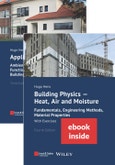Bad experiences with construction quality, the energy crises of 1973 and 1979, complaints about "sick buildings", thermal, acoustical, visual and olfactory discomfort, the need for good air quality, the move towards energy efficiency, decarbonization and sustainability - all these have accelerated the development of a discipline that, for a long time, was hardly more than an academic exercise: building physics. The discipline embraces domains such as heat and mass transfer, building acoustics, lighting, indoor environmental quality, energy efficiency, and, in some countries, fire safety. Through the application of physical knowledge and its combination with information coming from other disciplines, building physics helps to under-stand the physical phenomena governing building parts, building envelope, whole building and built environment performance - called urban physics. Today, building physics has be-come a key player on the road to highly performing new buildings and renovations.
The first book deals with heat, air and moisture transport in building parts or assemblies and whole buildings with emphasis on the building engineering applications.
The second book on applied building physics focuses on the question of what a well-balanced building performance consists of. Here, the environmental loads on buildings are explained - i.e. all those parameters that describe the external and internal environmental conditions, with an emphasis on practical implementation. Then follows a comprehensive presentation of those performance requirements that are important at the whole-building level, mainly considering thermal, acoustic, visual and olfactory comfort, indoor air quality, energy consumption, durability, economy and sustainability. This is followed by an in-depth discussion of the requirements regarding thermal, air and moisture behaviour as well as the measured variables at the level of the building construction and components.
The analyses and calculations described in this book result in sustainable buildings made of functional and durable building constructions, with comfortable and healthy indoor climate.
Compared to the previous editions, both books have been expanded to include the physical determination of the thermal conductivity of materials, together with an in-depth discussion of all the effects of thicker insulation layers. Additional information has been added on wind pressure and the evaluation of condensation inside the building components, while a new chapter on material properties has been included.
Both volumes, including the figures, have been revised and restructured where necessary.
(Package: Print + eBook)
The first book deals with heat, air and moisture transport in building parts or assemblies and whole buildings with emphasis on the building engineering applications.
The second book on applied building physics focuses on the question of what a well-balanced building performance consists of. Here, the environmental loads on buildings are explained - i.e. all those parameters that describe the external and internal environmental conditions, with an emphasis on practical implementation. Then follows a comprehensive presentation of those performance requirements that are important at the whole-building level, mainly considering thermal, acoustic, visual and olfactory comfort, indoor air quality, energy consumption, durability, economy and sustainability. This is followed by an in-depth discussion of the requirements regarding thermal, air and moisture behaviour as well as the measured variables at the level of the building construction and components.
The analyses and calculations described in this book result in sustainable buildings made of functional and durable building constructions, with comfortable and healthy indoor climate.
Compared to the previous editions, both books have been expanded to include the physical determination of the thermal conductivity of materials, together with an in-depth discussion of all the effects of thicker insulation layers. Additional information has been added on wind pressure and the evaluation of condensation inside the building components, while a new chapter on material properties has been included.
Both volumes, including the figures, have been revised and restructured where necessary.
(Package: Print + eBook)
Table of Contents
BOOK 1 BUILDING PHYSICSPreface
Units and Symbols
0 Introduction, History of Building Physics
1 Heat Transfer
1.1 Generalities
1.2 Conduction
1.3 Heat Exchange at Surfaces by Convection and Radiation
1.4 Building Related Applications
1.5 Problems and Solutions
2 Mass Transfer
2.1 Generalities
2.2 Air
2.3 Water Vapour
2.4 Moisture
2.5 Problems and Solutions
3 Heat, Air, and Moisture Combined
3.1 Why?
3.2 Material and Assembly Level
3.3 Whole Building Level
3.4 Problems and Solutions
4 Heat, Air, Moisture Material Properties
4.1 In general
4.2 Dry Air and Water
4.3 Thermal Properties of selected building materials
4.4 Air Properties
4.5 Moisture Properties
Postscript
BOOK 2 APPLIED BUILDING PHYSICS
Preface
Units and Symbols
Introduction, Historical Review
1 Ambient Conditions Out and Indoors
1.1 Overview
1.2 Outdoors
1.3 Indoors
Further Reading
2 Performance Metrics and Arrays
2.1 Definitions
2.2 Functional Demands
2.3 Performance Requirements
2.4 A short history
2.5 Performance arrays
Further Reading
3 Functional Demands at the Whole Building Level
3.1 In brief
3.2 Thermal, acoustical, visual and olfactory comfort
3.3 Health and Indoor environmental quality (IEQ)
3.4 Energy Efficiency
3.5 Durability
3.6 Economics
3.7 Sustainability
3.8 High performance buildings
Further Reading
4 Heat, Air, Moisture Metrics at the Building Assembly Level
4.1 Introduction
4.2 Air-tightness
4.3 Thermal transmittance
4.4 Transient thermal response
4.5 Moisture tolerance
4.6 Thermal bridging
4.7 Contact coefficient
4.8 Hygrothermal stress and strain
4.9 Transparent parts: solar transmittance
Further Reading
5 The Envelope Parts HAM Performances Applied to Timber-Frame
5.1 In general
5.2 Assembly
5.3 Performance evaluation
Further Reading
Appendix: Heat, Air, Moisture Material Properties
Index








